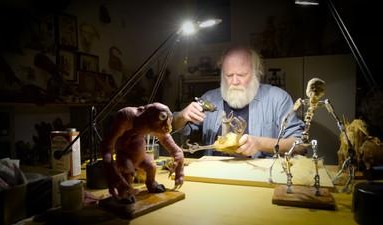Installation view, Michael Rakowitz, The worst condition is to pass under a sword which is not one's own, Tate Modern, January–May 2010. © Michael Rakowitz. Photo © Tate Photography.
Installation view, Michael Rakowitz: Backstroke of the West, MCA Chicago September 16, 2017—March 4, 2018 Photo: Nathan Keay, © MCA Chicago
Rakowitz: At the start of the Iraq War, it was the existence of an antiquities art market that allowed for the National Museum of Iraq to be looted in the first place. Those artifacts ended up in places like Sotheby's and other auction houses, but in the early days of the looting, some of them ended up on sites like eBay.I had been seeing on eBay that Saddam Hussein's personal china was available from various venders. One of them was an American veteran based in Baghdad at the time. He had gotten them from Iraqi sellers who had looted the palaces in the aftermath of the shock-and-awe campaign and were using his plates as their own dinnerware. I thought it was so fascinating for these objects of power to be dispersed to the Iraqi populace.The other seller was an Iraqi living in Michigan whose father was a high-ranking officer in the Republican Guard. I thought these two sources were really interesting. We have an American veteran who's there, and an Iraqi refugee who's here.
Watch more from VICE:

How did their perception of the origin of the plates differ?
The only reason why those plates would ever make it to somebody's table was because the American invasion overthrew this leader. His plates had a different meaning for Iraqis, because there was a very complicated relationship with Saddam that wasn't rosy. But the fact that it was a Western power that came in and yet again imprisoned or executed an Iraqi leader was a repeat of the British and Western-backed coups that happened in succession throughout the 60s and onwards.
Installation view, Michael Rakowitz, The worst condition is to pass under a sword which is not one's own, Tate Modern, January–May 2010. © Michael Rakowitz. Photo © Tate Photography.
In 1994, when I was studying public art, I bought a book called The Monument by Kanan Makiya with an image [of the Hands of Victory] on the cover. It reminded me of the poster I had from The Empire Strikes Back that was given away for free when I saw it as a kid. It hung over my bed. You have this looming evil-doer Darth Vader with two crossed, red lightsabers hovering over the protagonists in the foreground. I immediately thought of those crossed lightsabers when I saw the monument of the crossed swords.I ended up in Beirut in 2008 for a conference, and this incredible art historian named Nada Shabout was giving an overview of Iraqi art, and she talked about the Swords of Qādisīyah, the Victory Arch. And on the eve of the first Gulf War, the night before it was supposed to begin on January 15, 1991, Saddam actually had the Iraqi army marching underneath the crossed swords to the theme song from Star Wars, which was played over and over again and televised across the country. I was like, Whoa, that's two connections!
Michael Rakowitz, May the Arrogant Not Prevail, 2010. Found Arabic packaging and newspapers, glue, cardboard, and wood; 35 ¼ x 194 ¼ x 37 ½ in. (597.5 x 493.4 x 95.3 cm). Collection Museum of Contemporary Art Chicago, gift of Marshall Field's by exchange, 2015.4 Image courtesy of the artist and Rhona Hoffman Gallery
It's meant to explore pathos. Everybody that I've spoken to or read about, it doesn't matter if you were for the war or against the war, when the Iraq museum was looted, it was a catastrophe. Something that was a local problem suddenly became a global problem, a human problem.You're talking about the first writing, the first code of urban laws. I thought that was an event that might unify. And it's naive, but if you could have this outrage over stolen artifacts, what about the missing and stolen lives and dreams of the Iraqi people? The interruption that this country has experienced is unimaginable, and the people who give up everything that they were striving for to become refugees just trying to survive… We don't think about those things enough. So I was a little bit outraged that the outrage ended there, with the objects, and that it didn't translate.
Installation view, Michael Rakowitz: Backstroke of the West, MCA Chicago September 16, 2017—March 4, 2018 The invisible enemy should not exist, (2007–ongoing) Photo: Nathan Keay, © MCA Chicago
Yes, exactly. I thought about making something that lost its provenance, by being looted and being sold on the black market. It is about that artifact being elsewhere, the same way Iraq is elsewhere. And it's a violent push to elsewhere, it's not a choice, and so now you look at those artifacts and it's the fragments of this cultural visibility that are being enlisted to make things that are now invisible.
Michael Rakowitz, May the Arrogant Not Prevail, 2010. Collection Museum of Contemporary Art Chicago, gift of Marshall Field's by exchange. Image courtesy of the artist and Rhona Hoffman Gallery.
The Iraq War was such an unpopular war. The fact that it could go on the way it did is an immense problem that I feel like I grapple with every single day. I would like to be part of a world that doesn't allow it to happen again.I do think that if we demand a better, kinder, and more hospitable place, we can construct that through our acts and through our actions.Follow B. David Zarley on Twitter.
